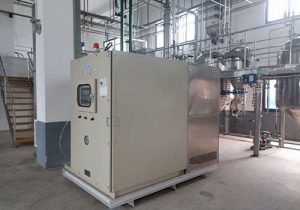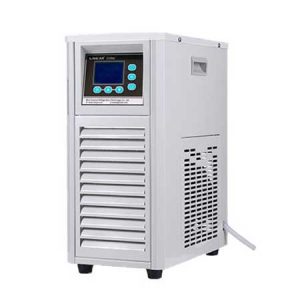water chiller plant working
A water chiller plant is a complex system designed to produce chilled water, which acts as a heat transfer medium to cool spaces, machinery, or industrial processes. Its operation is centered on the refrigeration cycle, a continuous process that removes heat from water and dissipates it to the environment, ensuring the chilled water can repeatedly absorb heat from the target area.

The core of a water chiller plant is the chiller unit, which performs the refrigeration cycle, combined with a distribution system for chilled water and a heat rejection system. The key components work together in a coordinated sequence to achieve cooling.
The refrigeration cycle within the chiller unit starts with the evaporator. Chilled water from the distribution loop flows through the evaporator, where it comes into contact with a cold refrigerant. The refrigerant, in a low-pressure, low-temperature liquid state, absorbs heat from the water, causing the refrigerant to vaporize into a gas. As a result, the water is cooled (typically to between 4°C and 12°C) before being pumped back into the distribution system to absorb more heat from the cooling load.
The low-pressure refrigerant vapor is then drawn into the compressor. The compressor increases the pressure of the vapor, which raises its temperature significantly—often to a level higher than the ambient air or cooling water used for heat rejection. This high-pressure, high-temperature vapor is essential for efficient heat transfer in the next stage.
From the compressor, the high-pressure refrigerant vapor moves to the condenser. Here, the refrigerant releases the heat it absorbed from the chilled water. In water-cooled chiller plants, the condenser is cooled by water from a cooling tower; heat from the refrigerant transfers to this cooling water, which is then sent to the tower to dissipate the heat into the atmosphere. In air-cooled plants, the condenser uses fans to blow ambient air over its coils, transferring heat directly to the air. As the refrigerant releases heat, it condenses back into a high-pressure liquid.
The high-pressure liquid refrigerant proceeds to the expansion valve (or metering device), which restricts the flow of refrigerant, reducing its pressure and temperature. This converts the refrigerant into a low-pressure, low-temperature mixture of liquid and vapor, which re-enters the evaporator to absorb more heat from the chilled water, completing the cycle.
Beyond the chiller unit, the distribution system plays a critical role. Chilled water pumps circulate the cooled water from the evaporator through a network of pipes to air handlers, cooling coils, or process equipment. In large plants, primary pumps maintain a constant flow through the chiller, while secondary pumps adjust flow based on the cooling demand of the load, ensuring efficient water distribution.
Air handlers or cooling coils in the target area use the chilled water to cool the air. Warm air from the space passes over the cold coils, transferring heat to the chilled water. The now-warmed water returns to the evaporator to be cooled again, creating a closed loop.
In water-cooled plants, the heat rejection system includes a cooling tower and condenser water pumps. The condenser water, after absorbing heat in the condenser, is pumped to the cooling tower. The tower uses evaporation to release heat: a fan draws air through the tower, and a portion of the water evaporates, lowering the temperature of the remaining water. The cooled condenser water is then recirculated back to the condenser to absorb more heat.

Control systems regulate the entire plant’s operation. Sensors monitor the temperature of the chilled water supply and return, as well as the cooling demand from the load. Building management systems (BMS) adjust the chiller’s output, pump speeds, and fan operation to match demand, optimizing energy use. For example, if the chilled water return temperature is lower than the setpoint, the control system may reduce the compressor’s capacity or slow the pumps to save energy.
Water treatment systems are essential to protect the plant’s components. Chilled water and condenser water are treated with chemicals to prevent corrosion, scaling, and biological growth (such as algae or bacteria). Filtration systems remove debris that could clog coils or pumps, maintaining efficient heat transfer and extending equipment life.
The operation of water-cooled and air-cooled chiller plants differs primarily in their heat rejection methods, which affects efficiency and setup. Water-cooled plants are more efficient because water is a better heat transfer medium than air, allowing the condenser to operate at lower temperatures. This efficiency makes them ideal for large facilities like hospitals, universities, and industrial complexes, though they require additional infrastructure (cooling towers, condenser water pumps) and water treatment.
Air-cooled plants, by contrast, do not need a cooling tower or condenser water loop, simplifying installation and reducing maintenance. They are suitable for smaller facilities or locations with limited water access but are less efficient, especially in hot climates, as higher ambient air temperatures reduce condenser performance.

Several factors influence the efficiency of a water chiller plant. The temperature difference (ΔT) between the chilled water supply and return is critical; a larger ΔT indicates the water is absorbing more heat, reducing the flow rate needed and saving energy. Properly sized pipes and pumps minimize pressure drops, ensuring water flows efficiently through the system.
Chiller part-load efficiency is another key factor. Most plants operate at part load most of the time, so chillers with variable speed compressors or multiple units (staged operation) adjust output to match demand, avoiding energy waste. Regular maintenance, such as cleaning condenser and evaporator coils, checking refrigerant levels, and calibrating controls, also maintains efficiency.
Water quality directly impacts performance. Scaling on heat exchanger surfaces reduces heat transfer, forcing the chiller to work harder. Corrosion can damage pipes and coils, leading to leaks and reduced flow. Effective water treatment and filtration prevent these issues, ensuring the plant operates at peak efficiency.
In summary, a water chiller plant works by using the refrigeration cycle to cool water, distributing this chilled water to absorb heat from the cooling load, and rejecting the absorbed heat to the environment. Whether water-cooled or air-cooled, the system relies on coordinated operation of components like chillers, pumps, condensers, and controls to provide efficient, reliable cooling. Understanding this process helps in optimizing performance, reducing energy costs, and ensuring the plant meets the cooling needs of its application.
Related recommendations
What are the Precautions for Installing a Chiller?
1524What are the Precautions for Installing a Chiller? Chiller is a kind of water cooling equipment, which can provide constant temperature, constant flow and constant pressure cooling equipment....
View detailsHow to maintain an industrial water chiller machine?
1373How to maintain an industrial water chiller machine? 1、 Regularly check whether the voltage and electric flow of the chiller are stable, and whether the sound of the compressor is norm...
View detailssmall chiller system
407Key Features of Small Chiller Systems:Portability: Compact design for easy installation in tight spaces. Energy Efficiency: Optimized for low power consumption. Precision Cooling: Maintains ...
View detailswater baths laboratory
630Water Baths Laboratory: Types, Applications, and Working Principles Introduction to Water Baths LaboratoryWater baths are essential laboratory equipment used to maintain samples at a controlled...
View details
 LNEYA Chiller
LNEYA Chiller







HelloPlease log in